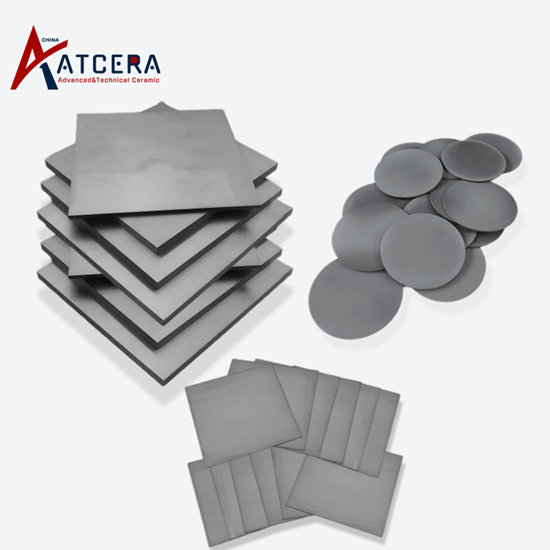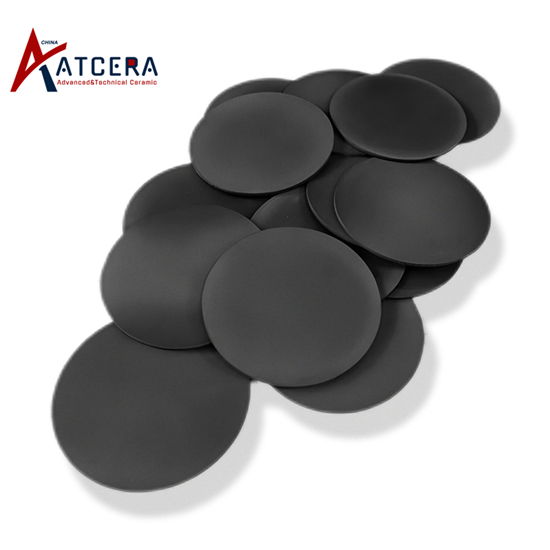첨단 전자공학의 역동적인 세계에서 앞서 나가기 위한 열쇠는 끊임없는 혁신 추구에 있습니다. 기술이 빠른 속도로 계속 발전함에 따라 고성능 Si3N4 반도체 기판이 산업 혁명의 선두 주자로 떠오르고 있습니다. 탁월한 열 안정성, 기계적 강도 및 전기 절연 특성을 갖춘 Si3N4 기판은 이전과는 전혀 다른 고급 전자 장치의 진정한 힘을 발휘합니다.
Si3N4 기판을 전자 장치에 통합함으로써 제조업체는 성능과 효율성의 경계를 넓힐 수 있습니다. 이러한 기판은 전자 부품의 전력 처리 기능을 향상시켜 더 빠른 데이터 전송 속도, 향상된 열 관리 및 향상된 신뢰성을 가능하게 합니다. 스마트폰, 자동차 전자 제품, 항공우주 응용 분야 등 Si3N4 기판은 우리가 기술을 경험하는 방식을 변화시키고 있습니다.
빠르고 안정적이며 에너지 효율적인 전자 장치에 대한 수요가 계속 증가함에 따라 Si3N4 반도체 기판은 업계를 미래로 이끌 준비가 되어 있습니다. 강도와 절연 특성의 독특한 조합으로 인해 첨단 전자 장치 개발에 필수적인 요소가 되었습니다.
따라서 버클을 채우고 Si3N4 반도체 기판이 제공하는 무한한 가능성을 탐색할 준비를 하십시오. 첨단 전자제품의 미래는 여기서 시작됩니다.
Si3N4 반도체 기판의 장점
질화 규소(Si3N4) 반도체 기판은 첨단 전자 분야의 판도를 바꾸는 요소로 등장하여 업계에 혁명을 일으키는 다양한 이점을 제공합니다. Si3N4 기판의 주요 장점 중 하나는 탁월한 열 안정성입니다. 기존 반도체 소재와 달리 Si3N4는 구조적 무결성이나 전기적 특성을 손상시키지 않고 고온을 견딜 수 있습니다. 이러한 열 복원력은 전자 부품이 전력 전자 장치, 고주파 장치 및 자동차 전자 장치와 같이 강한 열에 노출되는 응용 분야에서 매우 중요합니다.
Si3N4 기판의 또 다른 주요 장점은 뛰어난 기계적 강도입니다. 이러한 기판은 높은 수준의 응력과 변형을 견딜 수 있는 능력으로 유명하므로 내구성과 신뢰성이 가장 중요한 응용 분야에 이상적인 선택입니다. 이러한 기계적 강도는 또한 기판이 민감한 전자 부품에서 열을 효과적으로 전달하여 전체 시스템 성능과 수명을 향상시킬 수 있으므로 향상된 열 방출로 이어집니다.
Furthermore, Si3N4 semiconductor substrates possess excellent electrical insulation properties, which is a critical factor in the design and fabrication of high-performance electronic devices. These substrates effectively isolate electrical signals, preventing cross-talk and ensuring signal integrity, which is essential for applications such as radio frequency (RF) and high-speed digital circuits. This insulating property also contributes to the improved power handling capabilities of Si3N4-based electronic devices, enabling them to operate at higher voltages and power levels without compromising reliability.
Applications of Si3N4 semiconductor substrates in advanced electronics
The exceptional properties of Si3N4 semiconductor substrates have made them an indispensable component in a wide range of advanced electronic applications. In the realm of power electronics, Si3N4 substrates are widely used in the manufacture of high-power transistors, inverters, and motor drives. These substrates provide the necessary thermal management and electrical insulation, allowing power electronic devices to operate at higher voltages and switching frequencies, resulting in improved efficiency and reliability.
In the automotive industry, Si3N4 semiconductor substrates have become increasingly prevalent, particularly in the design of electronic control units (ECUs) and other safety-critical components. The robust mechanical properties and thermal stability of these substrates ensure that automotive electronics can withstand the harsh environmental conditions encountered in vehicles, such as extreme temperatures, vibrations, and shocks. This, in turn, enhances the overall reliability and safety of modern automobiles.
The aerospace and defense sectors have also embraced the use of Si3N4 semiconductor substrates, as these applications often demand the highest levels of performance and reliability. In these industries, Si3N4 substrates are utilized in a variety of electronic systems, including radar, avionics, and satellite communications. The unique combination of thermal, mechanical, and electrical properties offered by Si3N4 substrates enables the development of advanced electronic systems that can operate reliably in the demanding environments encountered in aerospace and defense applications.

The future of Si3N4 semiconductor substrates in the electronics industry
As the demand for faster, more efficient, and more reliable electronic devices continues to grow, the role of Si3N4 semiconductor substrates in shaping the future of the electronics industry cannot be overstated. With the ever-increasing complexity and power requirements of modern electronic systems, the exceptional properties of Si3N4 substrates make them an increasingly attractive choice for manufacturers and designers.
Looking ahead, the integration of Si3N4 semiconductor substrates into a wide range of electronic devices is expected to accelerate. From next-generation smartphones and wearables to cutting-edge industrial automation and renewable energy systems, Si3N4 substrates will play a crucial role in enabling the development of high-performance, energy-efficient, and reliable electronic components.
Furthermore, the ongoing research and development in the field of Si3N4 substrate manufacturing processes are expected to drive further advancements in the technology. Improvements in material quality, manufacturing techniques, and cost-effectiveness will likely lead to the widespread adoption of Si3N4 substrates across the electronics industry, solidifying their position as the preferred choice for a wide range of applications.
Manufacturing process of Si3N4 semiconductor substrates
The manufacturing of high-quality Si3N4 semiconductor substrates involves a complex and meticulous process that requires precise control over various parameters. The production of Si3N4 substrates typically begins with the synthesis of the raw material, silicon nitride, through a chemical reaction between silicon and nitrogen.
One of the most common methods for producing Si3N4 is the chemical vapor deposition (CVD) process, where silicon and nitrogen-containing precursor gases are introduced into a reaction chamber and subjected to high temperatures. This process allows for the controlled deposition of a thin, uniform layer of Si3N4 on a suitable substrate, such as silicon or sapphire.
Following the Si3N4 deposition, the substrate undergoes a series of precision machining and polishing steps to ensure a smooth, defect-free surface. This surface preparation is crucial, as it directly impacts the performance and reliability of the electronic devices that will be fabricated on the substrate.
To further enhance the properties of the Si3N4 substrate, various post-processing techniques may be employed, such as thermal annealing or the application of protective coatings. These additional steps help to optimize the substrate's thermal, mechanical, and electrical characteristics, making it better suited for specific electronic applications.
The manufacturing of Si3N4 semiconductor substrates requires a high level of expertise, advanced equipment, and stringent quality control measures to ensure the production of consistently reliable and high-performing materials. As the demand for these substrates continues to grow, manufacturers are continuously innovating and improving their processes to meet the ever-evolving needs of the electronics industry.
Key properties and characteristics of Si3N4 semiconductor substrates
The exceptional properties and characteristics of Si3N4 semiconductor substrates are what make them so valuable in the world of advanced electronics. One of the most notable features of Si3N4 is its exceptional thermal stability, which allows it to withstand high temperatures without compromising its structural integrity or electrical performance. This thermal resilience is particularly crucial in power electronics and high-power applications, where the substrate must be able to effectively dissipate heat generated by the electronic components.
In addition to its thermal stability, Si3N4 is renowned for its exceptional mechanical strength and hardness. These properties contribute to the substrate's ability to withstand high levels of stress and strain, making it an ideal choice for applications where durability and reliability are paramount, such as in automotive electronics and aerospace systems.
Another key characteristic of Si3N4 semiconductor substrates is their excellent electrical insulation properties. These substrates are highly effective at isolating electrical signals, preventing cross-talk and ensuring signal integrity, which is essential for high-frequency and high-speed digital circuits. This insulating capability also allows Si3N4-based electronic devices to operate at higher voltages and power levels without compromising reliability.
Furthermore, Si3N4 substrates exhibit a low coefficient of thermal expansion, which closely matches that of the semiconductor materials commonly used in electronic devices. This thermal compatibility helps to minimize the risk of thermal-induced stresses and failures, contributing to the overall reliability and performance of the electronic systems.
The combination of these exceptional properties – thermal stability, mechanical strength, electrical insulation, and thermal compatibility – makes Si3N4 semiconductor substrates a highly sought-after material in the electronics industry, enabling the development of cutting-edge electronic devices that are more powerful, efficient, and reliable than ever before.
Challenges and limitations of Si3N4 semiconductor substrates
While Si3N4 semiconductor substrates offer numerous advantages, they are not without their challenges and limitations. One of the primary challenges in the widespread adoption of Si3N4 substrates is the relatively higher cost compared to traditional semiconductor materials, such as silicon or gallium arsenide.
The manufacturing process of Si3N4 substrates is complex and requires specialized equipment, as well as a high level of expertise and quality control measures. This, in turn, can drive up the overall production costs, making Si3N4 substrates less accessible for some manufacturers, especially in price-sensitive markets.
Another limitation of Si3N4 substrates is their relatively lower thermal conductivity compared to some other semiconductor materials, such as silicon carbide (SiC) or diamond. While Si3N4 substrates exhibit excellent thermal stability, their ability to dissipate heat may be slightly less efficient in certain high-power applications, where the thermal management requirements are particularly demanding.
Additionally, the manufacturing of large-diameter Si3N4 substrates can be more challenging and may result in higher defect rates, limiting the availability of large-scale wafers for high-volume production. This can be a constraint for manufacturers who require larger substrate sizes to meet their specific design and production needs.
Despite these challenges, the electronics industry is continuously working to address the limitations of Si3N4 substrates through ongoing research and development.
Advancements in manufacturing processes, material engineering, and cost-reduction strategies are expected to help overcome these obstacles and further drive the adoption of Si3N4 substrates in the future.
Comparison of Si3N4 semiconductor substrates with other semiconductor materials
When it comes to semiconductor substrates, Si3N4 stands out as a unique and highly capable material, offering a combination of properties that are often unmatched by other semiconductor materials. One of the primary advantages of Si3N4 over traditional silicon (Si) substrates is its superior thermal stability and mechanical strength.
While silicon is a widely used semiconductor material, it can be susceptible to thermal degradation and mechanical failures at high temperatures or under high-stress conditions. In contrast, Si3N4 substrates can withstand much higher temperatures and exhibit greater resistance to mechanical stress, making them a better choice for power electronics, high-frequency, and harsh-environment applications.
Another semiconductor material that has gained significant attention in recent years is silicon carbide (SiC). Like Si3N4, SiC also offers excellent thermal stability and mechanical strength, making it a viable alternative for advanced electronic applications. However, Si3N4 substrates generally have a lower coefficient of thermal expansion, which can be advantageous in terms of thermal compatibility with semiconductor devices and reduced thermal-induced stresses.
Gallium nitride (GaN) is another semiconductor material that has seen increasing adoption in high-power and high-frequency electronics. While GaN-based devices can offer excellent performance, they often require specialized substrate materials, such as sapphire or SiC, to support their unique properties. In this context, Si3N4 substrates can serve as a cost-effective and compatible alternative, providing a suitable platform for the integration of GaN-based components.
In terms of electrical insulation properties, Si3N4 substrates outperform many other semiconductor materials, including silicon and gallium arsenide (GaAs). This superior insulation capability allows Si3N4-based electronic devices to operate at higher voltages and switching frequencies, improving overall efficiency and performance.
Overall, the unique combination of thermal, mechanical, and electrical characteristics of Si3N4 semiconductor substrates makes them a highly versatile and attractive choice for a wide range of advanced electronic applications, where the demand for high-performance, reliable, and efficient devices continues to grow.

Importance of high-performance Si3N4 semiconductor substrates in the development of advanced electronics
The role of high-performance Si3N4 semiconductor substrates in the development of advanced electronics cannot be overstated. As the electronics industry continues to push the boundaries of performance, efficiency, and reliability, these exceptional substrates have become an essential component in the quest for technological breakthroughs.
One of the key drivers behind the importance of Si3N4 substrates is the growing demand for power-dense and energy-efficient electronic devices. In industries such as automotive, aerospace, and renewable energy, the ability to handle high power levels while maintaining thermal stability and reliability is crucial. Si3N4 substrates, with their exceptional thermal management capabilities and mechanical strength, enable the design and manufacture of electronic components that can operate reliably under these demanding conditions.
Furthermore, the insulating properties of Si3N4 substrates are crucial in the development of high-frequency and high-speed electronic devices, such as those used in telecommunications, radar systems, and advanced computing. By effectively isolating electrical signals and preventing cross-talk, Si3N4 substrates help to ensure the integrity and performance of these mission-critical electronic systems.
As the world becomes increasingly reliant on advanced electronics, the need for reliable, durable, and efficient devices has never been more pressing. Si3N4 semiconductor substrates play a pivotal role in meeting these demands, enabling the creation of innovative electronic products that are better equipped to handle the challenges of the modern world.
From smartphones and wearables to industrial automation and renewable energy systems, the integration of high-performance Si3N4 substrates is transforming the electronics industry, paving the way for a future where advanced electronics are more powerful, efficient, and reliable than ever before.
Conclusion: The potential and outlook of Si3N4 semiconductor substrates in the electronics industry
전자 산업이 계속해서 빠른 속도로 발전함에 따라 첨단 전자 제품의 미래를 형성하는 데 있어 Si3N4 반도체 기판의 역할이 점점 더 분명해지고 있습니다. 비교할 수 없는 열 안정성, 기계적 강도 및 전기 절연 특성을 갖춘 이러한 뛰어난 소재는 이전보다 더 강력하고 효율적이며 신뢰할 수 있는 최첨단 전자 장치 개발에 중추적인 역할을 할 준비가 되어 있습니다.
Si3N4 기판은 전력 전자 장치 및 고주파 장치부터 자동차 및 항공우주 시스템에 이르기까지 광범위한 전자 응용 분야에 원활하게 통합될 수 있기 때문에 잠재력이 엄청납니다. 빠르고 안정적이며 에너지 효율적인 전자 장치에 대한 수요가 계속 증가함에 따라 Si3N4 기판은 기술 혁신의 최전선에 남아 제조업체가 가능한 것의 경계를 넓힐 수 있도록 할 것입니다.
앞으로 전자 산업에서 Si3N4 반도체 기판의 미래는 가능성으로 가득 차 있습니다. 지속적인 연구 개발 노력을 통해 재료 품질, 제조 공정 및 비용 효율성이 더욱 향상되어 궁극적으로 업계 전반에 걸쳐 이러한 기판이 널리 채택될 것으로 예상됩니다.
전자 분야 환경이 계속 발전함에 따라 Si3N4 기판의 다양성과 성능으로 인해 Si3N4 기판은 최첨단 고성능 전자 장치를 찾는 데 점점 더 필수적인 구성 요소가 될 것입니다. 주머니 속의 세련된 스마트폰부터 항공기의 첨단 항공 전자 시스템에 이르기까지 Si3N4 기판의 영향은 광범위한 산업 전반에 걸쳐 느껴지며 우리가 알고 있는 기술의 미래를 형성할 것입니다.
결론적으로, 전자 산업에서 Si3N4 반도체 기판의 잠재력은 정말 무한합니다. 더 빠르고 효율적이며 신뢰할 수 있는 전자 장치에 대한 수요가 계속 증가함에 따라 이러한 뛰어난 소재는 의심할 여지 없이 첨단 전자 장치의 새로운 시대를 열고 우리가 주변 세계와 상호 작용하고 경험하는 방식을 변화시키는 데 중추적인 역할을 할 것입니다.


























